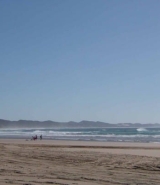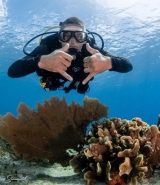Risk Management in Scuba Diving

It’s not the end, it’s the beginning.
“I was doing dives to over 30m/100 feet, at night, solo, with just that Open Water certification card (and an EAN certification). And night dives, boat dives, drift dives all without further formal certification training. So what was the problem?” Bob The Diver
Believe it or not, the above quote is genuine. No, really it is. I’ve paraphrased it slightly but that’s it. Ok, so the guy isn’t really called Bob. I made that bit up to protect the innocent. But I really saw it in on diving discussion board and involuntarily face-palmed. It’s not just that Bob did that, it’s that Bob also couldn’t see the error of his ways. This is all kinds of stupid. At some point, sometime, somewhere, without the relevant knowledge, training and equipment, Bob will end up getting his a*se handed to him as a hat.
Last Sunday I was sat behind a laptop in a classroom, beside a flat screen TV, with an audience of a few people looking at me like rabbits in the headlights. The rabbits were instructor candidates on the receiving end of my two-hour lecture on Risk Management. The poor souls. Now Risk Management, I freely admit, is not the most riveting subject in the world. In a diving fraternity populated by people wanting to be square-jawed, beardy and macho, sometimes safety is pushed to one side or brushed under the carpet. Disregarding or flaunting basic risk management is an odd mindset as, if you get it wrong, being beneath the surface of the sea is a pretty unforgiving environment.
You can’t wrap yourself up in cotton wool in life, and the fact there is a ‘danger’ element to being beneath the surface is part of diving’s attraction I guess. Everybody wants to be James Bond or Lara Croft. It’s just more exciting than buying a Pringle jumper and playing golf. But, if you’re clever, you can manage the risk of diving.
To be honest, the gung-ho attitude of Bob is less prevalent (but not necessarily absent) by the time divers get to the stage of studying to be Divemasters or Instructors. Control criteria and safety is something that’s drummed into you during your Divemaster and Instructor training. And rightly so. No one wants to think that whoever’s guiding them on the dive doesn’t give a sh*t if they make it back to the surface safely.
Some training organisations also put member agreements in place to ensure Divermaster and Instructors should play by the rules. Or, if you’re a professional diver in the UK, you have the HSE looking over your shoulder too. But, up till that point, there’s a big grey area. How do you know your limitations?
After passing your Open Water course you’re equipped with the basics of diving. It’s like passing your driving test and being given the keys to an Aston Martin. You’re solid on the basics. You know the basic rules of the road. But you’re not Jenson Button. Unless you have the right guidance and training (or you have a heavy right foot) there’s the strong possibility given a Aston Martin you could end up wrapped around a tree if you don’t stick to the rules. Or, in the case of diving, a visit to the recompression chamber. Or worse. Don’t get me wrong, scuba diving is statistically safe. But even as recently as 2006 DAN reported 138 fatalities. Most of those were diver error. Sticking within the bounds of your knowledge and training is key to a safe dive. Plan the dive, dive the plan is a cliché, but a worthwhile one.
You never stop learning in diving. Pretty much every dive teaches you something – no matter how many dives you’ve done. So, lets make the assumption that Bob did his PADI Open Water and PADI Enriched Air Nitrox training and examine what’s wrong with what he said:
- The PADI Open Water course (OWC) trains you to be a competent diver with a maximum depth of 18m/60ft. All the training is geared to that. Cast your mind back to your OWC. Do you remember what the maximum ascent rate is Bob? 18m/60ft/minute. So why do you think you were trained on Confined Water Dive 2 to cope without a mask for 1 minute? Why do you think on Confined Water Dive 3 you’re trained to complete an out-of-air/alternate air source swim with a buddy for 1 minute? Coincidence?
- When you began your OWC you signed an agreement that states, “Make all dives no decompression dives and allow a margin of safety. Have a means to monitor depth and time underwater. Limit maximum depth to my level of training and experience. Ascend at a rate of not more than 18 metres/60 feet per minute” and “I understand the importance and purposes of these established practices. I recognize they are for my own safety and well-being, and that failure to adhere to them can place me in jeopardy when diving.” Did you miss that meeting Bob? Or did you simply not read the paperwork before you signed it?
- You probably don’t know this Bob, but PADI Members (Divemasters and Instructors) sign a membership agreement stating that they will respect and reinforce the depth and supervisory restrictions as displayed on restricted PADI certifications. So, hopping on a charter boat on deciding to flagrantly disregard depth limits if you’re diving with a professional guide means you’re exposing them too. Responsible guides adhere to depth limits and say ‘no-one deeper than me’ in the briefing for a reason.
- Bob, brace yourself. I know this may be news to you but…the dive isn’t just about you. You have a buddy and (potentially) the rest of the group to consider. It’s a team game. Do you have the necessary skills and rescue training to deal with any issues on a more demanding dive? Or is it a case of ‘I’m alright Jack’?
- Finally Bob, on the subject of liability, who do you think is picking up the tab if it all goes wrong? Most off-the-peg holiday insurances will only cover you within the limits of your formal training. Need a trip to the chamber? I hope you have a few thousand Euros to spare. Go beyond your limits and you’re on your own sunshine. DAN, a great organisation, will cover divers regardless of depth. However, that’s only cover for the incident itself. Suffering with long-term problems? Can’t do your job due to a spinal bend which means you can’t drive or walk properly? You’re flying solo.
Of course dive centres make money from selling training courses. That’s their business. Restaurants make money by selling food. But, the training isn’t just to make the centre additional revenue – it’s for you to learn essential skills in each area of diving under supervision and in a risk-managed environment. Each area of Scuba diving from night diving, deep diving, boat diving, drift diving and self-reliant diving has skills to learn and little tricks-of-the-trade to help you dive more effectively and safely. And we’ll look at a few tricks-of-the-trade over the next few weeks.
Passing your Open Water course isn’t the end of your formal training; it’s the beginning of an infinite learning curve.
Dive safely.
The Scuba Monkey
 Destinations
Destinations









Your Comments
No comment yet on this page, your thoughts are welcome!
Have you been travelling or scuba diving here? Rate it!(3 votes, 4.67/5)